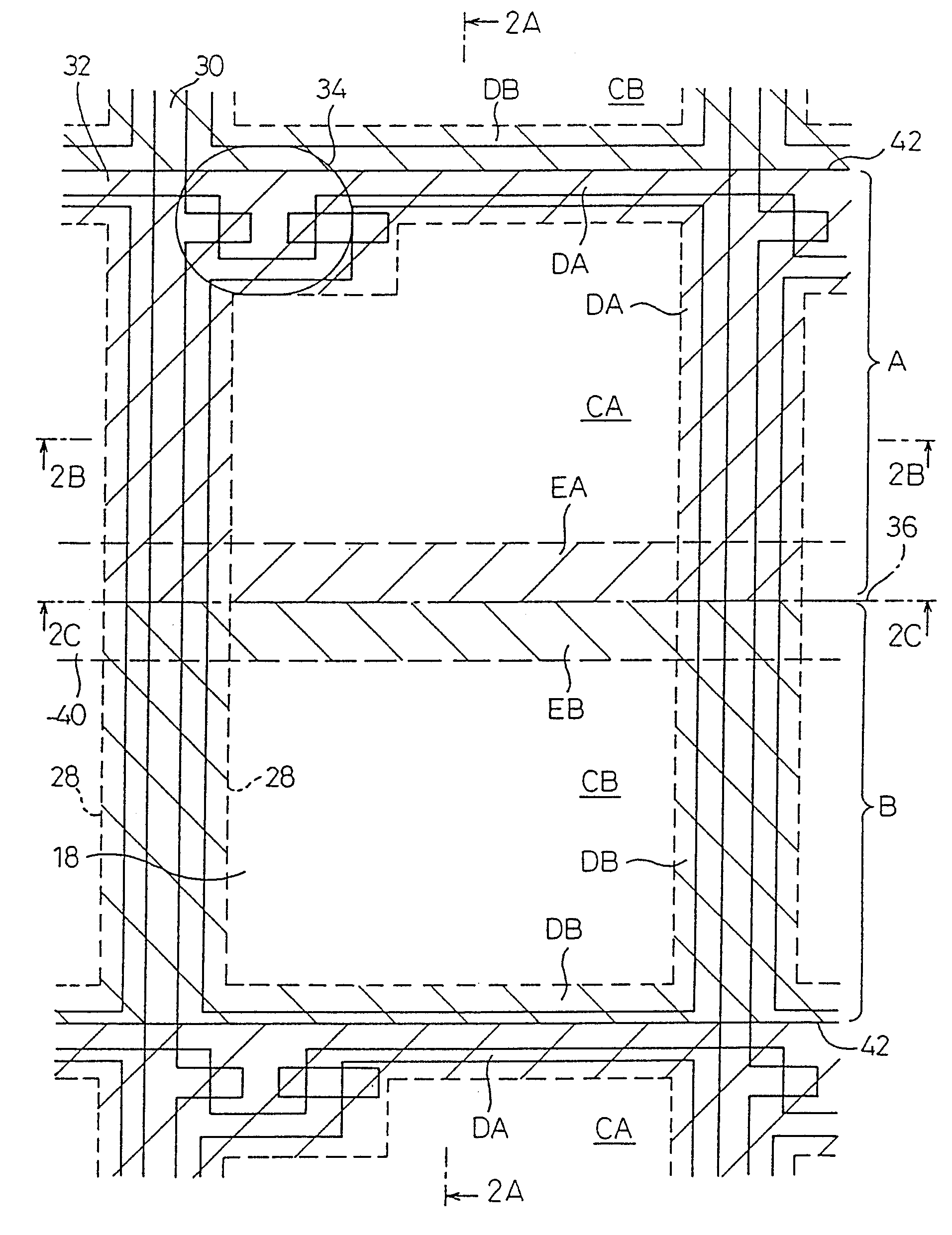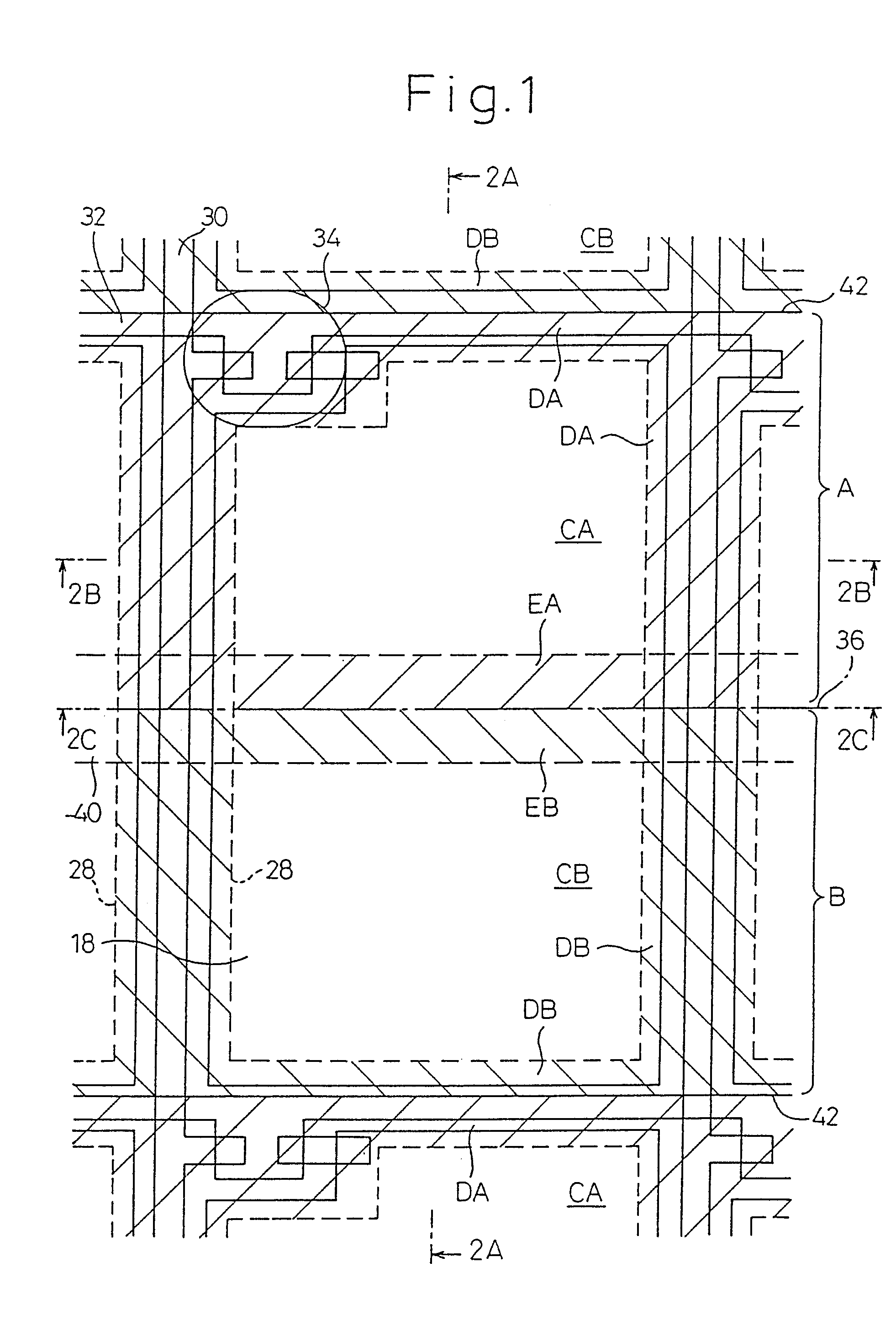Alignment treatment of liquid crystal display device
a liquid crystal display and alignment treatment technology, applied in the manufacture of electrode systems, electric discharge tubes/lamps, instruments, etc., can solve the problems of polarized ultraviolet rays, inconvenient practical use, and the loss of thin film transistors in the active matrix
- Summary
- Abstract
- Description
- Claims
- Application Information
AI Technical Summary
Benefits of technology
Problems solved by technology
Method used
Image
Examples
first embodiment
[0120]FIG. 1 is a plan view schematically illustrating a portion of a liquid crystal display device according to the present invention, FIGS. 2A to 2C are cross-sectional views illustrating the liquid crystal display device of FIG. 1, and FIG. 3 is a view illustrating an active matrix formed on one substrate of FIG. 2. In particular, FIG. 2A is a cross-sectional view taken along the line 2A-2A in FIG. 1, FIG. 2B is a cross-sectional view taken along the line 2B-2B in FIG. 1, and FIG. 2C is a cross-sectional view taken along the line 2C-2C in FIG. 1.
[0121]In FIGS. 2A to 2C, a liquid crystal display device 10 is constituted by a pair of spaced and opposed transparent glass substrates 12 and 14, and a liquid crystal layer 16 held between these substrates 12 and 14. On one substrate (lower substrate) 12 are formed transparent pixel electrodes 18 and a transparent alignment layer 20, and on the other substrate (upper substrate) 14 are formed a transparent common electrode 22 and a transp...
second embodiment
[0155]FIG. 16 is a view illustrating the present invention. Like the embodiment of FIG. 2, the liquid crystal display device 10 comprises a pair of spaced and opposed transparent glass substrates 12 and 14 and a liquid crystal layer 16 held between these substrates 12 and 14. On one substrate 12 are formed transparent pixel electrodes 18 and a transparent alignment layer 20, and on the other substrate 14 are formed a transparent common electrode 22 and a transparent alignment layer 24. On the upper substrate 14 are further formed a color filter 26 and a black matrix 28. The color filters 26 include color elements R, G and B. There is further provided a storage capacity electrode 40. The alignment layers realize alignments with pretilt angles, which are established without rubbing.
[0156]FIG. 17 illustrates an apparatus 60 for alignment-treating the alignment layer 20(24). The apparatus 60 for alignment treatment includes a source of light 62 for irradiating non-polarized ultraviolet ...
third embodiment
[0171]FIGS. 26A to 26D are views illustrating the alignment treatment according to the present invention. The alignment layer 20(24) shown here can be used in the liquid crystal display device shown in FIG. 16. Referring to FIG. 26A, the whole surface of the alignment layer 20 is rubbed with a rubbing roll 50, so that the liquid crystal molecules 16A are pretilted in a predetermined manner as shown in FIG. 26B. Referring to FIG. 26C, non-polarized ultraviolet rays 68A, 68B are projected in the opposite directions. Then, as shown in FIG. 26D, the realized pretilt angles in the domains A and B are the sums of a pretilt angle due to rubbing and pretilt angles due to irradiation with ultraviolet rays. Accordingly, a difference exists between the pretilt angles of the liquid crystal molecules in the two domains A and B.
[0172]The ultraviolet rays are irradiated in the manner described above. A lamp of the short arc-type is used as a source of light, ultraviolet rays of shorter than 280 nm...
PUM
| Property | Measurement | Unit |
|---|---|---|
| pretilt angle | aaaaa | aaaaa |
| pretilt angle | aaaaa | aaaaa |
| pretilt angle | aaaaa | aaaaa |
Abstract
Description
Claims
Application Information
 Login to View More
Login to View More - R&D
- Intellectual Property
- Life Sciences
- Materials
- Tech Scout
- Unparalleled Data Quality
- Higher Quality Content
- 60% Fewer Hallucinations
Browse by: Latest US Patents, China's latest patents, Technical Efficacy Thesaurus, Application Domain, Technology Topic, Popular Technical Reports.
© 2025 PatSnap. All rights reserved.Legal|Privacy policy|Modern Slavery Act Transparency Statement|Sitemap|About US| Contact US: help@patsnap.com



